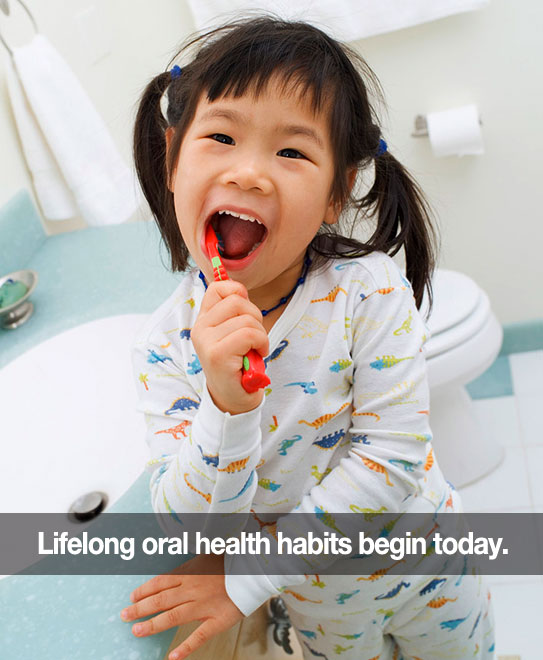How To Take Care Of Your Children’s Smiles

Every parent knows that taking care of the smallest members of the family can be a full-time job. Caring for small children includes many job duties, such as diaper changes, bath times, medical checkups, and kissing the occasional boo-boo. Just as important as these daily tasks, is the responsibility of taking care of your child’s smile.
If you are not certain about the best ways to take of your children’s teeth, you are not alone! Baby teeth need different care than adult teeth and gum health for small children can be hard to accomplish in some instances. Thankfully, there are some easy ways to care for your child’s teeth that will get them started on the right path for long-term oral hygiene.
If you want to learn more about the best ways to care for your child’s smile, read on to get advice from Dr. Gemmi and Dr. Middleberg on this important topic.
Birth to 18 Months
This is the age when children are getting their first baby teeth. At Orthodontics Limited, we believe that oral care is important for everyone, no matter their age. Our doctors are experts in pediatric orthodontics, and they recommend that you start cleaning your children’s teeth as soon as they begin to come in.
For babies younger than 18 months, the easiest way to do this is to wet a cloth or some gauze without toothpaste. This is the recommendation of pediatric orthodontics, to prevent your very young child from ingesting too much toothpaste during the cleaning process.
Simply rub the teeth and the gums gently with the cloth or the gauze looped over the end of your finger. This little bit of care, combined with nursing/drinking water, is enough oral hygiene for these young children. Once your child has begun to get their full set of baby teeth, you can start using a small, soft toothbrush to brush their teeth with water.
As leading orthodontists in Philadelphia, we believe that daily attention to teeth must start as soon as teeth come in to help avoid cavities later in life.
18 Months and Older
Pediatric orthodontics experts feel that children should not use toothpaste until they are 18 months old. This is the age where you can better control spitting out of the toothpaste and they will finally be eating foods that necessitate this kind of addition to their daily oral care.
When toothpaste is introduced to the process, young children should be supervised to make sure they are not swallowing the toothpaste and to guide them in proper brushing techniques. Be sure to purchase a children’s toothpaste for your child. It is formulated for their unique needs and is often made in flavors that children enjoy.
How to Pick the Right Children’s Toothpaste
When you are picking a children’s toothpaste, be sure to look for these key features:
- Fun Flavors: You may have to try a few flavors of toothpaste before you find on that your child likes best, but taking the time to find a flavor they like really helps encourage good brushing behavior. There are various flavors available on the market, from bubblegum, to grape, to other fun fruit flavors.
- Low-Fluoride: Fluoride is an important factor in healthy and strong teeth, but too much fluoride can actually be harmful to children. There are many brands of fluoride-free, or fluoride-reduced children’s toothpaste and these should be your go-to selections.
- Safe to Swallow: Children are going to swallow toothpaste when they are learning to brush their teeth, so children’s toothpastes are made to be safe to ingest. Always look for this feature to be listed on the tube before you pick out a toothpaste. Using adult toothpaste can make your child feel unwell if they swallow too much of it, but children’s toothpaste is formulated to avoid this issue.
- Use a Pea-Sized Amount: Using a small amount of toothpaste on your child’s toothbrush can prevent excess toothpaste from being ingested and it can also help your child to manage the amount of fluid in their mouth. Everyone who has helped a child brush their teeth knows that it can be a messy process at first, so using a small amount of toothpaste can help keep the mess down.
If you need help guiding the brushing process itself, consider taking advantage of the virtual orthodontic team to help guide and demonstrate proper brushing technique to you and your child.
When Can My Child Switch to Adult Toothpaste?
At our practice, we recommend that children switch to adult toothpaste with fluoride when they can reliably spit out most of the toothpaste after brushing. For many children, this is around ages 4-6. You will still want to use a pea-sized amount at this point, however, just in case they are still swallowing some of the toothpaste while they are brushing.
Always Remember
Brushing your child’s teeth is part of parenting and you will need to start making a habit of doing so when they are quite young. Taking the time each day before bed and in the morning when you get up will help keep your child’s teeth healthy and cavity-free.
Beyond caring for their baby teeth, you will be teaching your child how to properly care for their teeth to make sure that they can enjoy a lifetime of happy smiles!
Always remember to come in for regular checkups and cleanings so that your child’s teeth stay healthy and strong. You can set up an appointment with us through our handy contact page, or you can give us a call.
Join Our Family of Happy, Healthy Patients
Feel free to join our Facebook page and follow us on Twitter for more information about healthy oral habits and tip and tricks for daily oral care. Providing the right care for your child’s smile doesn’t have to be hard if you have access to the right support!
Schedule an appointment today for you or your child, and join our community of patients who enjoy healthy smiles from 18 months of age through adulthood.



Leave a Reply
You must be logged in to post a comment.